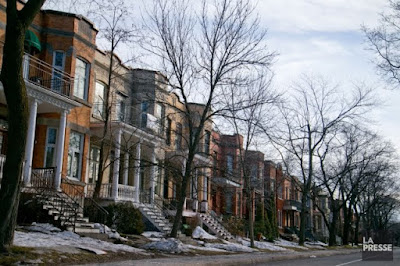It was on this tour that I learned something about the City Beautiful movement. This philosophy was prompted by the overcrowding of urban tenements in American cities, caused by a high birth rate, immigration and the relocation of rural inhabitants to the cities. Its aim was to improve the lives of city dwellers; its critics thought there was too much concern with aesthetics and not enough with social reform.
About 90% of the Outremont that we know today was built between 1890 and 1930, when the City Beautiful movement was at its height. The city used architectural zoning laws to control its development. For example, the northern end was designated as industrial, with working-class housing nearby, transitioning to homes for the middle-class and, near the southern border, to residences for the most affluent. Commerce was restricted to two main arteries.
 |
All homes were required to have 20-foot setbacks from the sidewalks, meaning that everyone had a front garden. Back alleys concealed delivery trucks, power lines, clotheslines and trash pick-up. Even though only a small number of architects was responsible for the vast majority of houses, an attempt was made to have a variety of facades, giving visual texture and interest to the streetscape.
Residential architecture in Outremont has aged well. What were originally planned as homes for the working class now strike us as a notch or two above that.
 |
Our guide scoffed at the ideals of the City Beautiful movement, whose advocates believed that its principles would foster "upright moral character" in its inhabitants. But I think that people are affected by their environments, and that a quiet and orderly neighbourhood, with access to green spaces, will go a long way to alleviating stress in urban dwellers. When you observe which neighbourhoods have held their value over the decades, you'll often find that those with the most stringent building codes fare best.
Too, the parks and the alleyways, as well as the public institutions, all afford residents opportunities to form connections and a sense of ownership.
What wasn't mentioned on the guided tour is that the community is now somewhat divided, between a large Hassidic minority and the non-Hassidic majority. Zoning restrictions on synagogues are one source of conflict. Even the best-intentioned building codes cannot always resolve such issues.




No comments:
Post a Comment